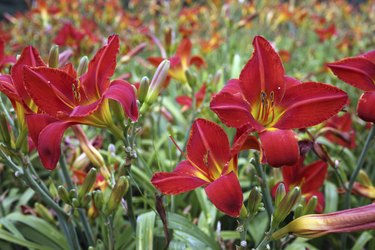
Daylilies, herbaceous perennials in the Hemerocallis genus, are not to be confused with true lilies (Lilium candidum) that grow from bulbs. Daylilies grow in clumps of long, slender, fibrous roots or rod-shaped roots that have small roots on their bottoms. They're planted both in spring and fall, depending on local climate.
Daylily Basics
Video of the Day
Daylilies will grow in U.S. Department of Agriculture plant hardiness zones 4 through 9. Daylilies bloom for longer periods of time in warmer climates. A healthy daylily will give you three to four weeks of continuous blooming in Zone 4, but up to 10 months in Zone 9, according to the National Gardening Association.
Video of the Day
There are both evergreen daylilies that retain their leaves in winter in mild climates and species that go dormant as winter approaches. Most daylily blossoms last a single day then die, replaced by another, hence their name. They're typically sold both on-line as bare root plants and in nurseries both as bare root plants or in containers.
True lilies will grow in USDA zones 3a through 7a. (See Reference 7)
Best Planting Times
If you live in a colder climate, plant them in the spring after the last danger of frost has passed. That's when you'll most likely find bare-root daylilies in your local nursery. If you order a bare-root plant off the Internet and plant it in autumn, its roots may not have time to get established before hard winter freezes.
If you live in the warmer end of the daylily hardiness range, plant them in early spring or late autumn. If you plant them in July through September in conditions of heat and high humidity, they stand a good chance of rotting.
Location and Soil
Find a location in the sun if you live in a colder climate. Daylilies will tolerate some shade in warm climates. Daylilies typically need about six hours of sun a day.
Use a tiller or garden fork to mix a 2- to 4-inch deep layer of compost into the top 12 to 15 inches your garden bed before planting daylilies. This is all the additional nutrients they need to get them started. Applying excessive fertilizer may prevent them from growing flowers.
Planting Daylilies
If you're planting a bare-root daylily, dig a hole deep enough so the crown of the plant, where the stem meet the root, is about 1 inch below the ground when you spread the roots out without crowding or bending them. Fill in the soil around the roots, firm it with your hands and water well.
If you're planting a lily grown in a container, dig a hole twice as wide as the container. Ease the plant out of the container and place it in the hole so the top of the root ball is level with the ground, then fill in around it, tamp the soil carefully and water well.
Daylilies need about 1 inch of water each week during their spring and summer growing season.